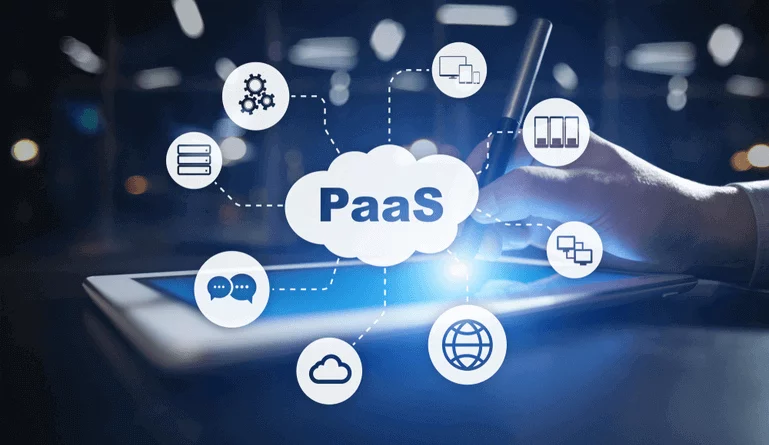A PaaS-based service is a comprehensive development and deployment infrastructure in the cloud, which offers you a range of services from basic cloud-based apps to complex, cloud-enabled business applications. A Cloud services provider (CSP) supply you with the resources you need on a pay-as-you-go basis, and they give you access to them over a secure Internet connection.
It is comparable to IaaS (Infrastructure as a Service), in that it comprises servers, networking, and storage infrastructure, and it also includes other tools and services, such as application development tools, database management systems, business intelligence (BI) services, and so on. Platform as a Service is built to help organizations develop, test, deploy, manage, and update their entire web application lifecycle.
PaaS frees you from the complexity and expense of purchasing and managing container orchestrators like Kubernetes, the underlying application middleware and infrastructure, software licenses, or resources and other tools for the development. The service provider handles everything except your apps and services, which you are allowed to manage.
The different types of PaaS
Several forms of PaaS (Platform as a Service) are accessible for developers today. They are as follows:
- Public Platform as a Service
- Private Platform as a Service
- Hybrid Platform as a Service
- Communications Platform as a Service
- Mobile Platform as a Service
- Open Platform as a Service
1. Public Platform as a Service
The best choice for the public cloud is the Public PaaS model. With a public Platform as a Service, the user is in charge of all application deployment, but the cloud provider handles the deployment of all other key IT components such as operating systems, servers, databases, and storage network infrastructures.
Middleware offered by public PaaS vendors allows developers to rapidly set up, manage, and control their servers and databases without requiring them to configure the underlying infrastructure. Combining these two cloud service models results in the public PaaS and infrastructure as a service (IaaS) working in tandem, with PaaS utilizing a vendor’s IaaS infrastructure on top of the public cloud. This, however, means the client is unable to freely pick and choose the cloud options that they want.
Public PaaS has been accepted by certain small and medium-sized firms, but enterprises and organizations larger than that have not embraced it because of its tight connections to the public cloud. The primary factor behind this is the vast number of regulations and compliance problems affecting enterprise application development on the public cloud.
2. Privately run Platform-as-a-Service
PaaS services strive to provide the agility of public Platforms as a Service while ensuring compliance, security, benefits and potentially costing less for the private data center. A private PaaS is almost often provided as software or appliance that runs within the firewall of the user, which is commonly maintained in the on-premises data center of the company. A private PaaS (Platform as a Service) can be built on any infrastructure, be used by the company’s private cloud, and work according to the specific requirements of the private cloud.
A private PaaS benefits developers use internal resources more efficiently and helps to curb the expensive cloud sprawl faced by several companies. Additionally, the flexibility that comes with running private PaaS offers the freedom to deploy and manage your company’s apps while simultaneously adhering to tight security and privacy standards.
3. Hybrid PaaS
Hybrid PaaS incorporates public and private PaaS to give business customers limitless capacity offered by public PaaS as well as reduced internal infrastructure costs in private PaaS. Hybrid PaaS is a combination of on-premises and public cloud infrastructure.
4. Communication PaaS
A Communication PaaS is a cloud-based platform that makes it easy for developers to integrate real-time communications in their applications without having to set up any back-end infrastructure or interfaces. In apps that are expressly intended for real-time conversations, it is more common to see real-time communications. Skype, WhatsApp, FaceTime, and the classic phone are all good examples.
The CPaaS real-time communications development framework offers a complete toolkit for developers who need to build their own development framework. This includes both APIs that are standards-based, software tools, sample code, and prebuilt apps.
5. Mobile Platform as a Service (mPaaS)
The usage of a paid integrated development environment (IDE) to configure mobile apps is known as Mobile PaaS (MPaaS). Coding abilities are not necessary for an MPaaS. To simplify the process, most MPaaS applications are hosted on the internet and enable private cloud, public cloud, and on-premises storage.
Object-oriented drag-and-drop interfaces provided by MPaaS make it simple for users to access device-specific functions such as the GPS, sensors, cameras, and microphone, helping users to simplify native app or HTML5 development. It is commonly used to support a number of mobile operating systems.
App development is commonly done using MPaaS in order to create both internal and customer-facing applications. BYOD works well in this deployment since productivity and other apps can be used without the need for mobile app developers or IT assistance.
6. Open PaaS
Free, open-source, and useful enterprise web apps, including contacts, calendar, and email, are included in the package with Open PaaS. With OpenPaaS, new apps can be deployed quickly. The aim of this project is to create a Platform-as-a-Service (PaaS) that will focus on enterprise collaboration applications, notably those that are being deployed on hybrid clouds.
(Also Read: The Difference Between IaaS and PaaS)
Typical PaaS use cases
PaaS is most commonly used by organizations for the following kinds of situations:
- Entrepreneurial framework. PaaS equips developers with a toolbox that they can use to build or enhance cloud-based apps. Like with the creation of Excel macros, PaaS helps developers build apps by employing software components that are already built into the system. Reduced code development, therefore, becomes achievable because of cloud features, including high availability, scalability, and multi-tenant characteristics.
- A combination of business intelligence and analytics. Services delivered via PaaS equip companies with the capacity to conduct data analysis and mining, thereby producing insights and patterns as well as predicting results that may be used to enhance forecasts, product design decisions, and returns on investment, in addition to other enterprise decisions.
- More services. Other services, such as workflow, scheduling, security, and directory, may be offered by PaaS providers to enhance applications.
The Benefits of PaaS
The same advantages are provided by providing infrastructure as a service, whether it is PaaS or IaaS. However, it also includes extra capabilities, such as development tools, middleware, and other enterprise tools, which provide you with distinct advantages.
- Cut down on the coding time. Platform-as-a-service (PaaS) development tools can reduce the time it takes to create new applications by providing pre-coded application components such as workflow, security features, directory services, search, and so on, which are already incorporated into the platform.
- You can expand development skills to a project without increasing staffing. Programming components that ate provided by a Platform as a Service (PaaS) can give your development team new capabilities without you needing to hire people that have the ability to use such features.
- Faster and easier to develop for numerous platforms, including mobile devices. A variety of service providers allow you to choose between several platforms when developing, such as PCs, mobile devices, and browsers, which allows you to create cross-platform apps much quicker and simpler.
- Affordably use advanced tools. It is feasible to employ very complex development software and business intelligence and analytics solutions that may be too expensive to purchase outright using a pay-as-you-go basis.
- Make it possible for geographically distant development teams to collaborate. Development teams can work together on projects from faraway locations because of the fact that development environments are accessed over the Internet.
- Run the application life cycle effectively. One of the strengths of Platform-as-a-Service (PaaS) is that it supplies all of the web application lifecycle capabilities you need, including developing, testing, deployment, management, and updating, in a single integrated environment.
To find out more how Platform as a Service Transforms IT, click here.





